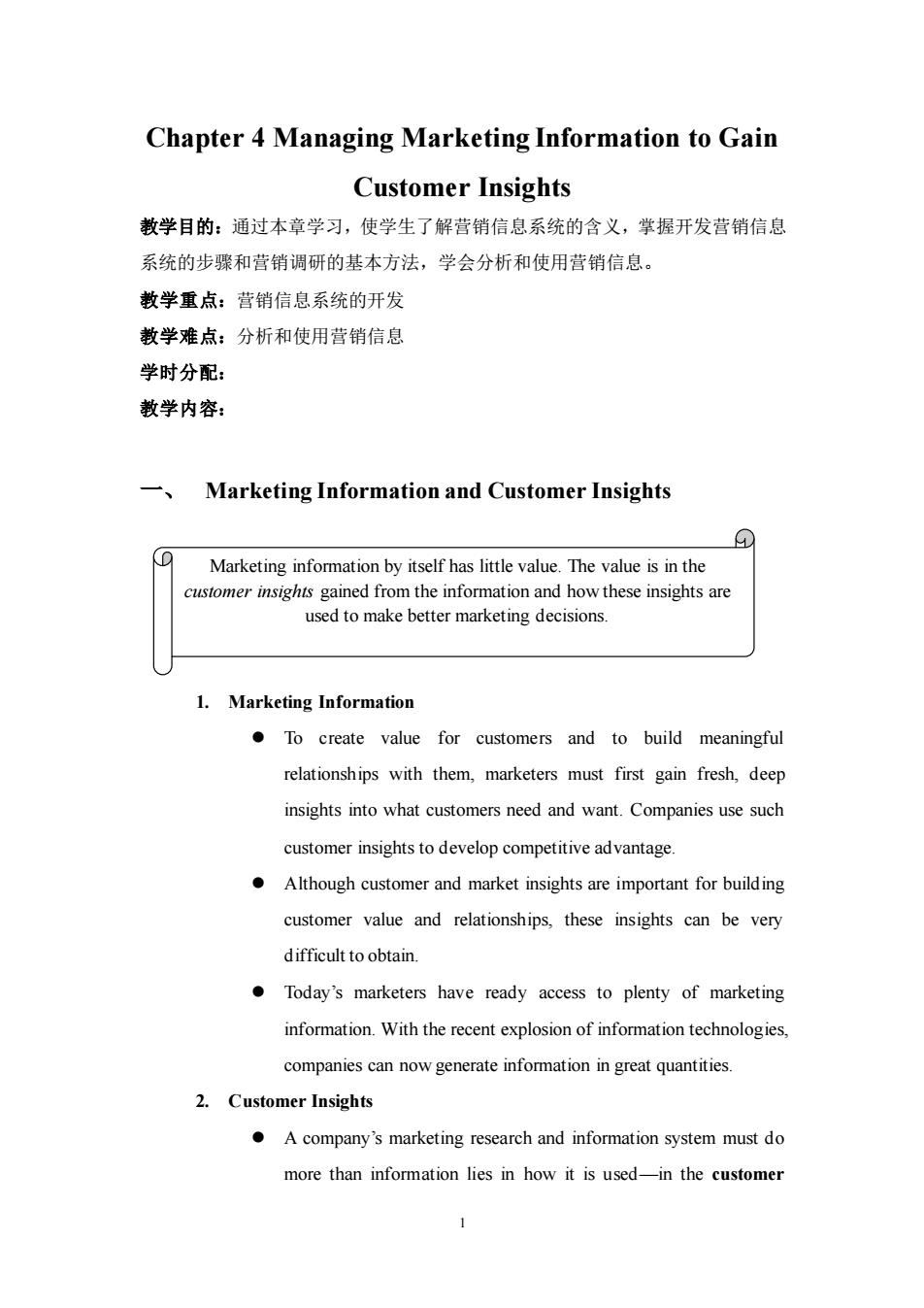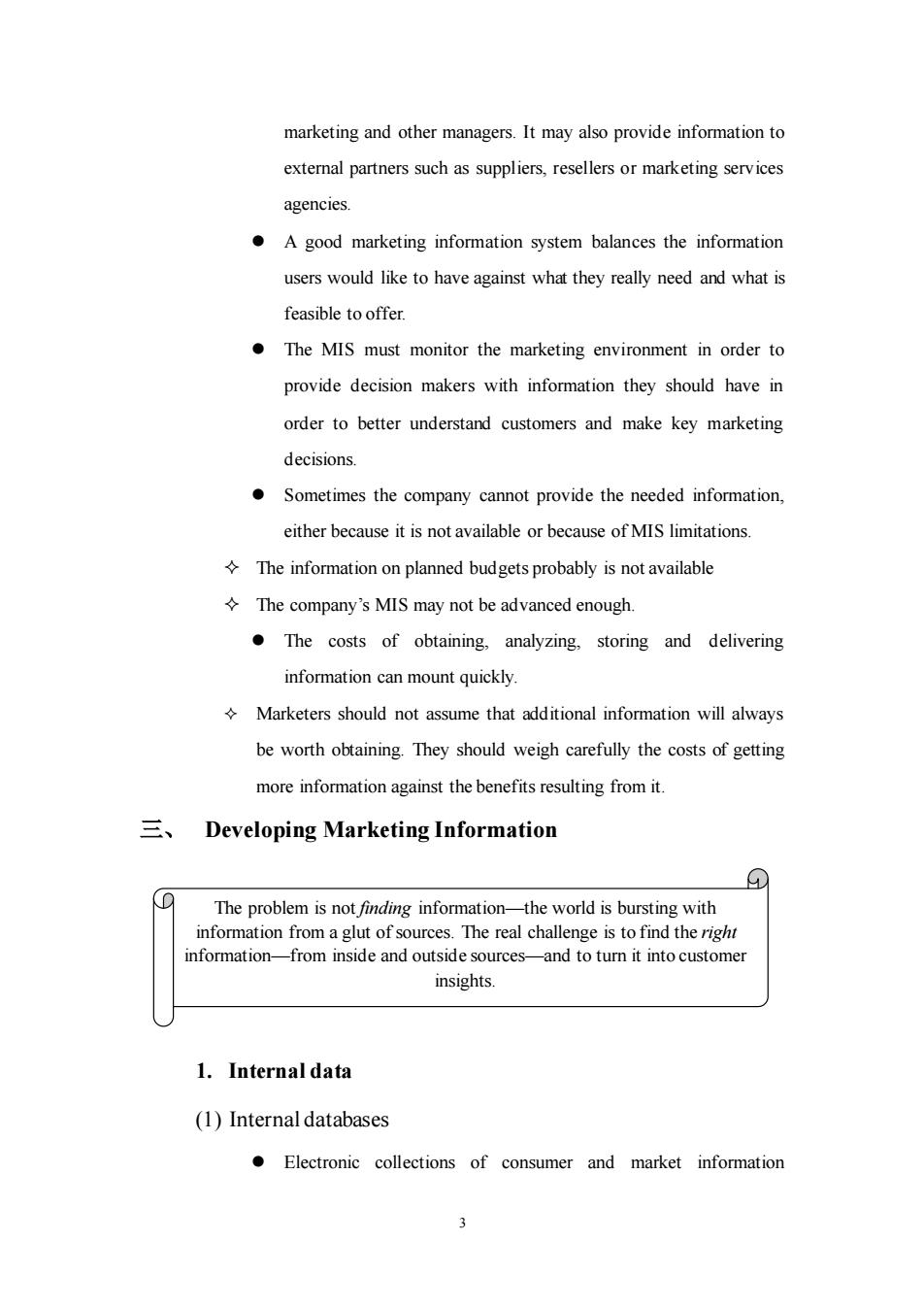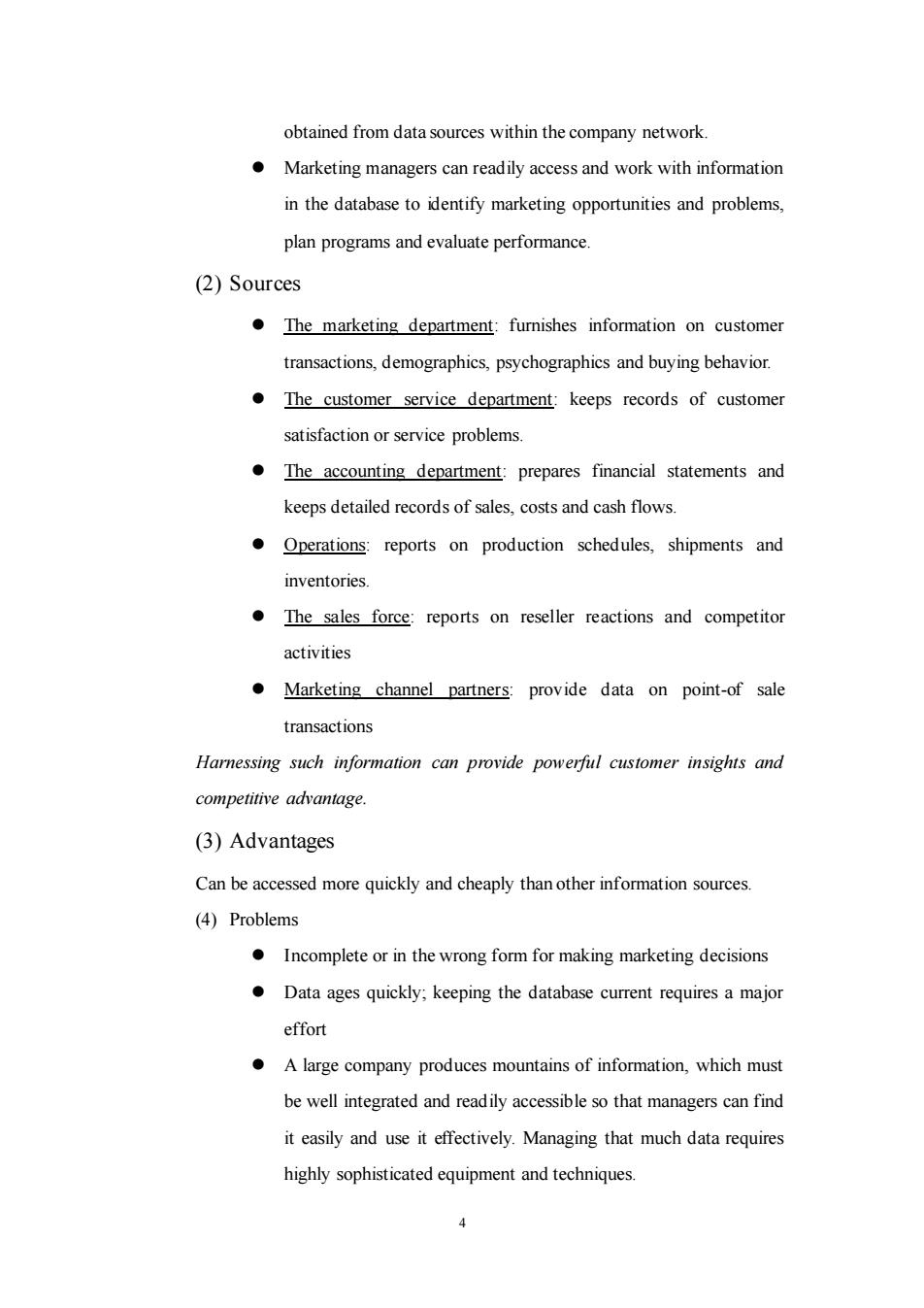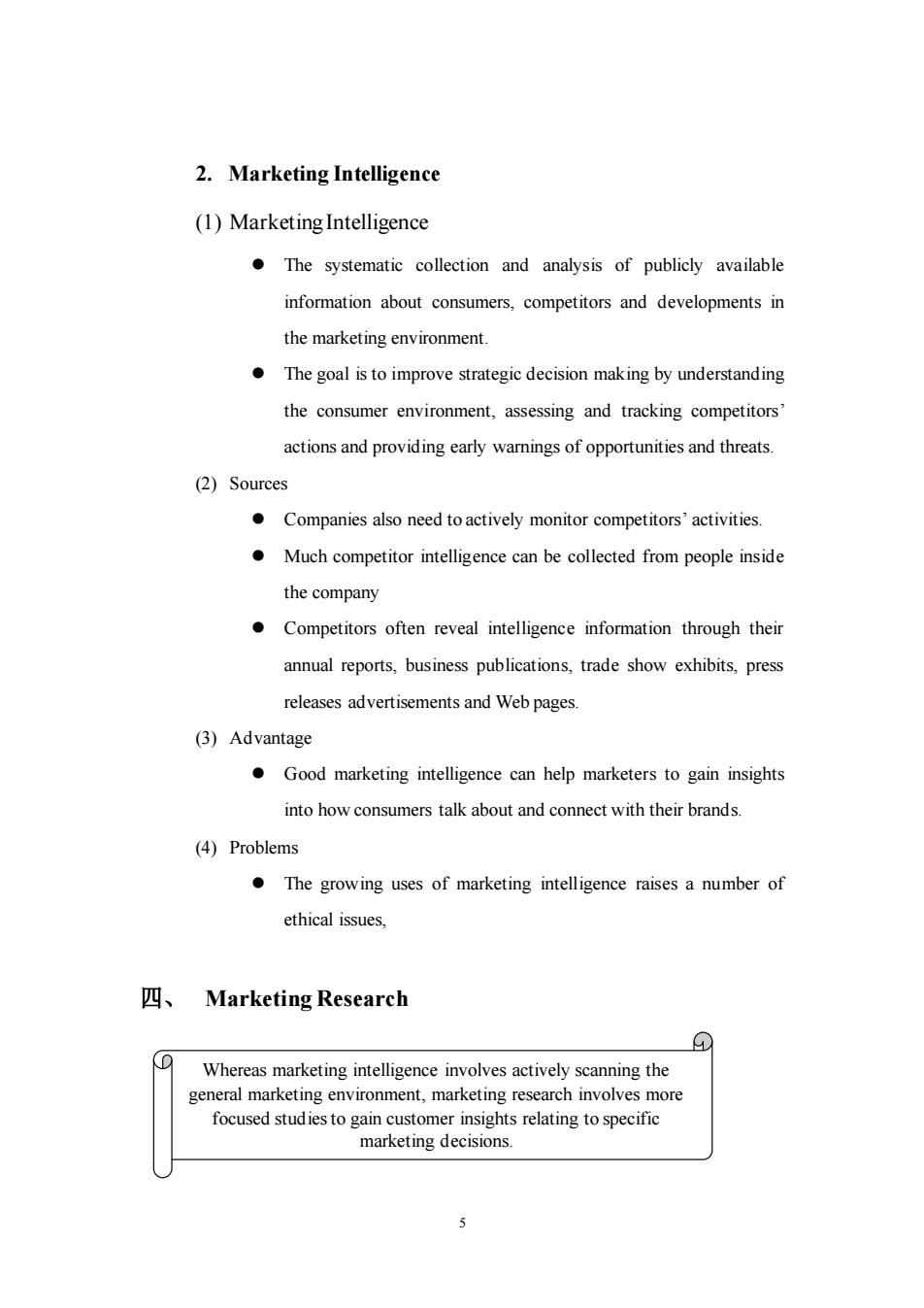
Chapter 4 Managing Marketing Information to Gain Customer Insights 教学目的:通过本章学习,使学生了解营销信息系统的含义,掌握开发营销信息 系统的步骤和营销调研的基本方法,学会分析和使用营销信息。 教学重点:营销信息系统的开发 教学难点:分析和使用营销信息 学时分配 教学内容: Marketing Information and Customer Insights Marketing information by itself has little value.The value is in the customer insighis gained from the information and how these insights are used to make better marketing decisions. Marketing Information To create value for customers and to build meaningful relationships with them,marketers must first gain fresh,deep insights into what customers need and want.Companies use such customer insights to develop competitive advantage Although customer and market insights are important for building customer value and relationships,these insights can be very difficult to obtain. Today's marketers have ready access to plenty of marketing information.With the recent explosion of information technologies companies can now generate information in great quantities 2.Customer Insights A company's marketing research and information system must do more than information lies in how it is used-in the customer
1 Chapter 4 Managing Marketing Information to Gain Customer Insights 教学目的:通过本章学习,使学生了解营销信息系统的含义,掌握开发营销信息 系统的步骤和营销调研的基本方法,学会分析和使用营销信息。 教学重点:营销信息系统的开发 教学难点:分析和使用营销信息 学时分配: 教学内容: 一、 Marketing Information and Customer Insights 1. Marketing Information ⚫ To create value for customers and to build meaningful relationships with them, marketers must first gain fresh, deep insights into what customers need and want. Companies use such customer insights to develop competitive advantage. ⚫ Although customer and market insights are important for building customer value and relationships, these insights can be very difficult to obtain. ⚫ Today’s marketers have ready access to plenty of marketing information. With the recent explosion of information technologies, companies can now generate information in great quantities. 2. Customer Insights ⚫ A company’s marketing research and information system must do more than information lies in how it is used—in the customer Marketing information by itself has little value. The value is in the customer insights gained from the information and how these insights are used to make better marketing decisions

insights (fresh understandings of customers and the marketplace derived from marketing information that become the basis for creating customer value and relationships)that it provides. Based on such thinking,many companies are now restructuring and renaming their marketing research and information functions. In gathering and using customer insights,companies must be careful not to go too far and become customer controlled.The idea is to understand customers to the core and give them what they need-to create value for customers as s means of capturing value for the firm in retum Companies must design effective marketing information systems that give managers the right information,in the right form,at the right time and help them to use this information to create customer value and stronger customer relationships 3.Marketing Information System A marketing information system(MIS)consists of people and procedures for assessing informational needs developing the needed information and helping decision makers to use the information to generate and validate actionable customer and market insights Figure 4.1 The Marketing Information System(Page 125) 二、 Assessing Marketing Information Needs The marketing information system begins and ends with users-with assessing their information needs and then delivering information that meets those needs. The marketing information system primarily serves the company's
2 insights (fresh understandings of customers and the marketplace derived from marketing information that become the basis for creating customer value and relationships) that it provides. ⚫ Based on such thinking, many companies are now restructuring and renaming their marketing research and information functions. ⚫ In gathering and using customer insights, companies must be careful not to go too far and become customer controlled. The idea is to understand customers to the core and give them what they need—to create value for customers as s means of capturing value for the firm in return. ⚫ Companies must design effective marketing information systems that give managers the right information, in the right form, at the right time and help them to use this information to create customer value and stronger customer relationships. 3. Marketing Information System ⚫ A marketing information system (MIS) consists of people and procedures for assessing informational needs developing the needed information and helping decision makers to use the information to generate and validate actionable customer and market insights. Figure 4.1 The Marketing Information System (Page 125) 二、 Assessing Marketing Information Needs ⚫ The marketing information system primarily serves the company’s The marketing information system begins and ends with users—with assessing their information needs and then delivering information that meets those needs

marketing and other managers.It may also provide information to external partners such as suppliers,resellers or marketing services agencies. A good marketing information system balances the information users would like to have against what they really need and what is feasible to offer. The MIS must monitor the marketing environment in order to provide decision makers with information they should have in order to better understand customers and make key marketing decisions. Sometimes the company cannot provide the needed information. either because it is not available or because of MIS limitations. The information on planned budgets probably is not available The company's MIS may not be advanced enough The costs of obtaining.analyzing,storing and delivering information can mount quickly. Marketers should not assume that additional information will always be worth obtaining.They should weigh carefully the costs of getting more information against the benefits resulting from it. 三、 Developing Marketing Information The problem is not finding information-the world is bursting with information from a glut of sources.The real challenge is to find the right information-from inside and outside sources-and to turn it into customer insights. 1.Internaldata (1)Internal databases Electronic collections of consumer and market information
3 marketing and other managers. It may also provide information to external partners such as suppliers, resellers or marketing services agencies. ⚫ A good marketing information system balances the information users would like to have against what they really need and what is feasible to offer. ⚫ The MIS must monitor the marketing environment in order to provide decision makers with information they should have in order to better understand customers and make key marketing decisions. ⚫ Sometimes the company cannot provide the needed information, either because it is not available or because of MIS limitations. The information on planned budgets probably is not available The company’s MIS may not be advanced enough. ⚫ The costs of obtaining, analyzing, storing and delivering information can mount quickly. Marketers should not assume that additional information will always be worth obtaining. They should weigh carefully the costs of getting more information against the benefits resulting from it. 三、 Developing Marketing Information 1. Internal data (1) Internal databases ⚫ Electronic collections of consumer and market information The problem is not finding information—the world is bursting with information from a glut of sources. The real challenge is to find the right information—from inside and outside sources—and to turn it into customer insights

obtained from data sources within the company network Marketing managers can readily access and work with information in the database to identify marketing opportunities and problems plan programs and evaluate performance. (2)Sources The marketing department:furnishes information on customer transactions,demographics,psychographics and buying behavior The customer service department:keeps records of customer satisfaction or service problems. The accounting department:prepares financial statements and keeps detailed records of sales,costs and cash flows. Operations:reports on production schedules,shipments and inventories. The sales force:reports on reseller reactions and competitor activities Marketing channel partners:provide data on point-of sale transactions Harnessing such information can provide powerful customer insights and competitive advantage. (3)Advantages Can be accessed more quickly and cheaply than other information sources. (4)Problems Incomplete or in the wrong form for making marketing decisions Data ages quickly:keeping the database current requires a majo effort A large company produces mountains of information,which must be well integrated and readily accessible so that managers can find it easily and use it effectively.Managing that much data requires highly sophisticated equipment and techniques
4 obtained from data sources within the company network. ⚫ Marketing managers can readily access and work with information in the database to identify marketing opportunities and problems, plan programs and evaluate performance. (2) Sources ⚫ The marketing department: furnishes information on customer transactions, demographics, psychographics and buying behavior. ⚫ The customer service department: keeps records of customer satisfaction or service problems. ⚫ The accounting department: prepares financial statements and keeps detailed records of sales, costs and cash flows. ⚫ Operations: reports on production schedules, shipments and inventories. ⚫ The sales force: reports on reseller reactions and competitor activities ⚫ Marketing channel partners: provide data on point-of sale transactions Harnessing such information can provide powerful customer insights and competitive advantage. (3) Advantages Can be accessed more quickly and cheaply than other information sources. (4) Problems ⚫ Incomplete or in the wrong form for making marketing decisions ⚫ Data ages quickly; keeping the database current requires a major effort ⚫ A large company produces mountains of information, which must be well integrated and readily accessible so that managers can find it easily and use it effectively. Managing that much data requires highly sophisticated equipment and techniques

2.Marketing Intelligence (1)Marketing Intelligence The systematic collection and analysis of publicly available information about consumers,competitors and developments in the marketing environment. The goal is to improve strategic decision making by understanding the consumer environment,assessing and tracking competitors actions and providing early warnings of opportunities and threats (2)Sources Companies also need to actively monitor competitors'activities. Much competitor intelligence can be collected from people inside the company Competitors often reveal intelligence information through their annual reports,business publications,trade show exhibits,press releases advertisements and Web pages (3)Advantage Good marketing intelligence can help marketers to gain insights into how consumers talk about and connect with their brands. (④)Problems The growing uses of marketing intelligence raises a number of ethical issues, 四、Marketing Research 9 Whereas marketing intelligence involves actively scanning the general m rketing environment,marketing research involves more focused studies to gain customer insights relating to specific marketing decisions
5 2. Marketing Intelligence (1) Marketing Intelligence ⚫ The systematic collection and analysis of publicly available information about consumers, competitors and developments in the marketing environment. ⚫ The goal is to improve strategic decision making by understanding the consumer environment, assessing and tracking competitors’ actions and providing early warnings of opportunities and threats. (2) Sources ⚫ Companies also need to actively monitor competitors’ activities. ⚫ Much competitor intelligence can be collected from people inside the company ⚫ Competitors often reveal intelligence information through their annual reports, business publications, trade show exhibits, press releases advertisements and Web pages. (3) Advantage ⚫ Good marketing intelligence can help marketers to gain insights into how consumers talk about and connect with their brands. (4) Problems ⚫ The growing uses of marketing intelligence raises a number of ethical issues, 四、 Marketing Research Whereas marketing intelligence involves actively scanning the general marketing environment, marketing research involves more focused studies to gain customer insights relating to specific marketing decisions